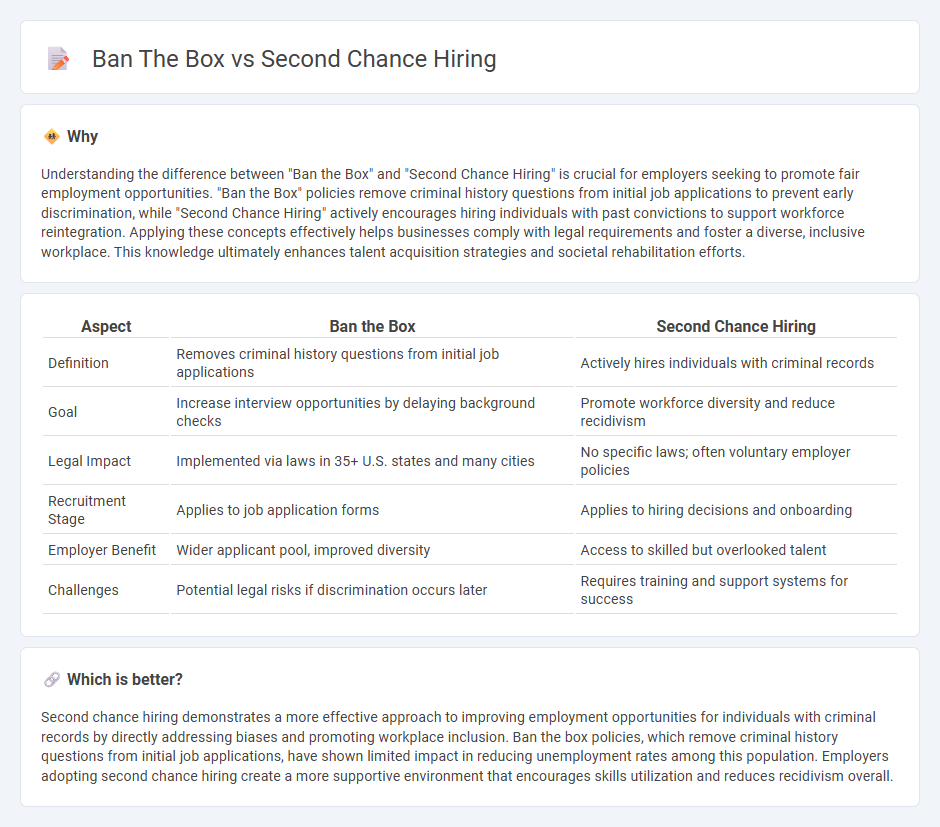
Ban the Box policies remove criminal history questions from initial job applications to reduce employment barriers for individuals with convictions, promoting fair hiring practices. Second Chance Hiring actively encourages employers to consider applicants with criminal records by providing resources and support, aiming to improve reintegration outcomes. Discover how these strategies reshape workforce inclusion and create opportunities for formerly incarcerated individuals.
Why it is important
Understanding the difference between "Ban the Box" and "Second Chance Hiring" is crucial for employers seeking to promote fair employment opportunities. "Ban the Box" policies remove criminal history questions from initial job applications to prevent early discrimination, while "Second Chance Hiring" actively encourages hiring individuals with past convictions to support workforce reintegration. Applying these concepts effectively helps businesses comply with legal requirements and foster a diverse, inclusive workplace. This knowledge ultimately enhances talent acquisition strategies and societal rehabilitation efforts.
Comparison Table
| Aspect | Ban the Box | Second Chance Hiring |
|---|---|---|
| Definition | Removes criminal history questions from initial job applications | Actively hires individuals with criminal records |
| Goal | Increase interview opportunities by delaying background checks | Promote workforce diversity and reduce recidivism |
| Legal Impact | Implemented via laws in 35+ U.S. states and many cities | No specific laws; often voluntary employer policies |
| Recruitment Stage | Applies to job application forms | Applies to hiring decisions and onboarding |
| Employer Benefit | Wider applicant pool, improved diversity | Access to skilled but overlooked talent |
| Challenges | Potential legal risks if discrimination occurs later | Requires training and support systems for success |
Which is better?
Second chance hiring demonstrates a more effective approach to improving employment opportunities for individuals with criminal records by directly addressing biases and promoting workplace inclusion. Ban the box policies, which remove criminal history questions from initial job applications, have shown limited impact in reducing unemployment rates among this population. Employers adopting second chance hiring create a more supportive environment that encourages skills utilization and reduces recidivism overall.
Connection
Ban the box policies remove questions about criminal history from initial job applications to reduce barriers for formerly incarcerated individuals seeking employment. Second chance hiring actively encourages employers to consider candidates with criminal records, promoting fair hiring practices and workforce reintegration. Both strategies work synergistically to improve employment opportunities and reduce recidivism by fostering inclusive hiring environments.
Key Terms
Criminal Record Disclosure
Second chance hiring policies encourage employers to consider job applicants with criminal records by limiting background checks early in the hiring process, promoting fair employment opportunities. Ban the Box laws specifically require the removal of criminal history questions from initial job applications to prevent automatic disqualification based on past convictions. Explore in-depth how these approaches impact criminal record disclosure and improve workforce inclusion.
Employer Liability
Second chance hiring policies reduce employer liability by promoting fair hiring practices and reducing discrimination claims related to criminal history. Ban the box laws specifically limit when employers can inquire about criminal records, minimizing early-stage bias but not fully protecting against liability from discriminatory hiring decisions. Explore how these approaches impact legal risks and hiring strategies for comprehensive employer guidance.
Fair Chance Policies
Fair Chance Policies, including Second Chance Hiring and Ban the Box initiatives, aim to reduce employment barriers for individuals with criminal records by promoting equitable hiring practices. Second Chance Hiring actively encourages employers to consider candidates' qualifications without discrimination, while Ban the Box mandates the removal of criminal history questions from initial job applications to prevent premature bias. Explore how these policies transform workforce inclusivity and support reentry success.
Source and External Links
The bottom-line benefits of second chance hiring | MIT Sloan - Second chance hiring involves employing people with criminal records, which can provide companies with reliable workers and improved retention rates during labor shortages, making it both a socially beneficial and economically smart practice.
Why Should the Transportation Industry Consider Second Chance Hiring | Union Pacific - Second chance hiring, as implemented by Union Pacific Railroad, includes reviewing policies, partnering with community organizations, securing leadership support, and training staff to safely integrate formerly incarcerated individuals into the workforce.
Second Chance Hiring | The Manufacturing Institute - The Manufacturing Institute provides a toolkit and resources to help manufacturers implement second chance hiring initiatives with key steps like planning, partnering, equipping, implementing, and sustaining such programs.
 dowidth.com
dowidth.com